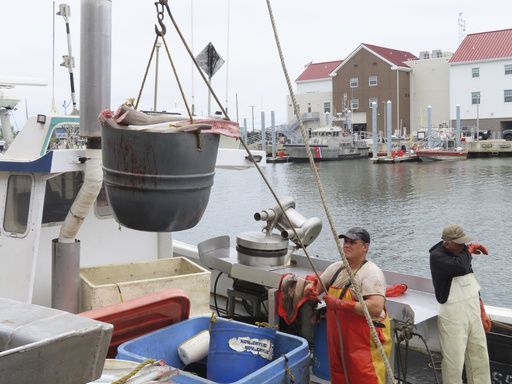As US East Coast ramps up offshore wind power projects, much remains unknown
Crew members of a fishing boat unload their catch in Point Pleasant Beach, N.J., on June 20, 2023. The commercial and recreational fishing industry has numerous concerns over offshore wind projects. The wind industry says it has tried to address those concerns, and will pay compensation for those that can’t be avoided. (AP Photo/Wayne Parry)
POINT PLEASANT BEACH, N.J. (AP) — As the U.S. races to build offshore wind power projects, transforming coastlines from Maine to South Carolina, much remains unknown about how the facilities could affect the environment.
And that worries some people, particularly those who depend on the sea for their livelihoods.
“We don’t have the science to know what the impact will be,” said Jim Hutchinson, managing editor of The Fisherman magazine in New Jersey. “The attitude has been, ‘Build it and we’ll figure it out.’”
The wind power industry disputes such claims, citing years of studies.
So far, four offshore wind projects have been approved by the federal government for the U.S. East Coast, according to the American Clean Power Association. Vineyard Wind will place 62 turbines about 15 miles off Martha’s Vineyard, generating enough electricity to power 400,000 homes.
South Fork Wind will place 12 turbines in the waters off Long Island, New York, about 35 miles east of Montauk Point, to power 70,000 homes. And Ocean Wind I, the first of two Orsted projects in New Jersey, will place 98 turbines about 15 miles off Atlantic City and Ocean City, generating power for 500,000 homes. The company is a Danish wind power business that will build two of the three offshore projects approved for New Jersey.
Those projects are in addition to the planned Revolution Wind development, about 15 miles southeast of Point Judith, Rhode Island, with 65 turbines powering nearly 250,000 homes. Numerous others have been proposed, and the U.S. Bureau of Ocean Energy Management plans to review at least 16 offshore wind projects by 2025.
“All this is happening so fast,” said Greg Cudnik, a recreational fisherman, bait and tackle shop owner and party boat captain from Ship Bottom, New Jersey. “Science takes time.”
A joint study in March by two federal scientific agencies and the commercial fishing industry documents numerous impacts that offshore wind power projects could have on fish and marine mammals, including noise, vibration, electromagnetic fields and heat transfer that could alter the environment.
Like numerous existing studies, the report pointed out the complexities of how the structures and cables might interact with marine life. For instance, turbines can attract some fish and repel others.
The March study said large underwater platforms are rapidly colonized by smaller, bottom-dwelling marine life, including shellfish and crabs, which in turn attract larger predators like black sea bass. At the same time, cloudy water from turbine operations, noise, vibrations and electromagnetic fields could also make species leave an area.
In most instances, report authors agreed that more studies are needed. Andy Lipsky, who oversees the wind energy team at NOAA’s Northeast Fisheries Science Center, is a co-author. He said the work helps agencies define monitoring required for long-term studies and that more work is required to determine how offshore wind energy changes marine habitats.
Research in other countries also is also nuanced. Some European studies have shown that crabs and lobster are attracted to harder sea bottoms that support wind turbines. Others, including flatfish and whiting, were shown to leave those areas.
And in May, the Biden Administration offered an $850,000 grant to collect more information on the hearing abilities of critically endangered North American right whales, citing “knowledge gaps” in how the animals behave. The request was made “in support of the rapid development of offshore wind,” according to a notice on the Grants.gov website.
Substantial research already exists. The U.S. Bureau of Ocean Energy Management has posted a half-dozen or more studies on its web site every year since 2016; in several instances the studies called for further investigation and analysis.
Phil Sgro, a spokesman for the American Clean Power Association, said the industry believes sufficient scientific studies exist to establish that offshore wind development can be done “in a manner that is both economical and environmentally responsible.”
Opponents blame ocean floor preparation for causing or contributing to the deaths of 70 whales on the U.S. East Coast since December. But three federal agencies say there is no evidence the two are related.
The U.S. fishing industry — both commercial and recreational — has numerous concerns about offshore wind impacting operations in places long available for fishing with minimal interference.
Interviews with commercial and recreational fishermen and women show they share common anxieties about the offshore wind turbines chasing away species they have long relied on.
They fear electromagnetic fields emitted from underwater power cables could deter or harm some marine life. They worry about being able to safely navigate around the turbines, and about being prohibited from productive fishing grounds on which they have relied for generations.
They also worry that unforeseen consequences could reduce catches and trigger government limits on how much can be caught if fish stocks diminish.
And while some companies have voluntarily agreed to compensate fishermen for any economic damage, there is no mandate requiring it.
“Offshore wind is the single greatest existential threat to commercial fishing in the United States of America right now,” Meghan Lapp, fisheries liaison for Seafreeze, a seafood company based in North Kingstown, Rhode Island, told New Jersey lawmakers at a recent hearing.
Cudnik, the New Jersey boat captain, worries about prime species being driven away by changes to the ocean floor.
“Clams, scallops, flounder, and sand eels are associated with soft sand bottoms,” he said. “Striped bass, sea bass, mahis — everything eats these eels. When they are in abundance, it’s awesome fishing. All these offshore wind areas are in that prime habitat.”
And Keith Craffey, president of the Baymen’s Protective Association on New Jersey’s Raritan Bay, worries that power cables from a New York project coming ashore in New Jersey will be placed across productive clam beds his members use, potentially rendering the areas off-limits.
“If we have to lay off 50 guys because of it, are the offshore wind companies going to pick those 50 guys up?” he asked.
On Monday, the U.S. Bureau of Ocean Energy Management released an environmental impact statement for the proposed Empire Wind project in New York, designed to power 700,000 homes. It determined that the project could have “moderate to major” impacts on commercial fisheries, and “minor to moderate” impacts for recreational fishing, although minor beneficial effects could also occur from the creation of an artificial reef that will attract some fish.
New Jersey’s commercial fishing industry had nearly $690 million in sales in 2020, not including imports, according to the U.S. Commerce Department. The recreational sector generated $724 million in sales that year.
Sgro said the wind power industry has worked closely with the government and the fishing industry to address concerns, including agreeing to avoid placing turbines in the areas most heavily used by anglers. He said a study in the waters off southern New England determined that heat and electromagnetic fields from buried cables will not negatively affect important fish species in the area.
Orsted, the developer behind two of New Jersey’s approved projects, said it has worked hard to “avoid, minimize and mitigate” negative impacts on fishing.
The company said a 7-year study of its wind farm in Block Island, Rhode Island, found the catch of most species was unaffected and that there was a greater abundance of black sea bass and cod after construction.
The study was paid for by Orsted, designed in cooperation with local commercial fishermen and carried out by INSPIRE Environmental, which does ocean floor studies for companies and governments.
Orsted says it will compensate boat crews for damage to or loss of gear; pay direct compensation to recreational and commercial vessels adversely impacted, and create a navigational safety fund. It also plans to coordinate with state and federal authorities on seasonal operating restrictions to protect flounder and herring.
The federal government has endorsed — but not required — compensation to the fishing industry for negative effects from offshore wind. Eleven states are considering setting up a regional fund to administer such payments.
U.S. Rep. Frank Pallone Jr., a New Jersey Democrat, supports the compensation “if the industry experiences economic losses as a result of the transition to offshore wind power.”
___
Follow Wayne Parry on X, the social media platform formerly known as Twitter, at twitter.com/WayneParryAC
Copyright 2023 The Associated Press. All rights reserved.


